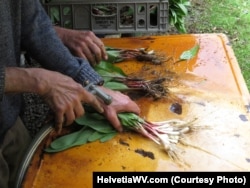The spring season brings warm weather, flowers and other changes for people to enjoy.
For some restaurant chefs, the most exciting spring arrival is ramps.
Every spring, restaurants across the United States compete to be the first to offer the seasonal vegetable.
The excitement has even created a ramps black market in Canada.
So, what is the great appeal of ramps? Maybe you have never even heard of them.
Ramps, or allium tricoccum, are a wild plant native to the eastern mountains of North America. They are one of the first plants that grow in the spring, usually between April and May. They are part of the same family as leeks and shallots. They are recognized by their red stem, and two long and broad green leaves.
They are also famous for their strong taste, similar to garlic, and other onions.
A spring treat
Ramps are not as well-known as other vegetables, but they have a long history in the United States.
In the Appalachian Mountains, ramps have been an important food for a long time. During spring, it is common for small towns in the Appalachian area to hold large ramp dinners for the community.
David Townsend owns the Mountain Roots Market and Restaurant, in Weston, West Virginia. He uses ramps every year, spending as much as a couple thousand dollars buying the plants.
Townsend told us he uses the vegetable in many ways. At his restaurant, for example, he might make ramp burgers. He also likes to mix ramps with potatoes and egg dishes. And he dries them for seasonings.
Townsend says you can also enjoy ramps fried, pickled, and even raw.
However, others might not enjoy the effect of ramps on your breath.
Townsend says, “The joke was that if you eat raw ramps, and you go to school, you would get kicked out of school because you stink.”
One reason the plant is popular is that it grows in the wild.
It is difficult to grow ramp crops on farms. Most restaurants get their supply from foragers. They are people who gather ramps by searching forests for patches, areas where they grow.
Townsend said the competitive market for the plant means that when someone finds a patch, they do not tell others where it is.
Small towns to big cities
In the past, ramps were mostly eaten in small towns in the areas where they grew. However, over the last 10 years, ramps’ popularity has grown quickly. They are now a highly-desired vegetable for many nice restaurants in cities like New York and Washington D.C.
Adam Harvey is the chef at Little Coco’s, an Italian restaurant in Washington D.C. He has been using ramps on his pizzas for about the last 10 years.
When spring comes, Harvey says, chefs around the country get excited for the arrival of the plant. They try to prepare it in as many ways as possible, and try to include as many choices as possible.
“It’s one of those things where people go a little crazy,” Harvey said. He adds that the popularity of ramps in nicer restaurants is a combination of several things.
“First, it has a really great flavor that is very individual… and second, it’s wild. It has such a short season, and you can’t get them all the time.” Harvey said.
Harvey also noted that many chefs want to keep their restaurant offerings seasonal. Ramps are the first “green thing” to grow after the winter, he said, so cooks feel a pull to use them.
Harvey said that his favorite way to cook ramps is to pickle the bulb, or bottom of the plant.
Problems with sustainability
Ramps have a short season. Within a few weeks of full growth, the plant is done for the year. This short life cycle is partly responsible for their popularity. And that popularity could lead to their disappearance from Earth.
Townsend said, “A lot of the public places where ramps are [grown]… have been over-dug… because of the amount of money that a person can make off them.” He added that people who sell ramps to restaurants in New York can sometimes make as much as $20 for half a kilogram.
“In two-to-three months, you can make two-to-three thousand dollars,” he said.
Townsend also said that not everyone who forages for ramps obeys the guidelines for protecting future growth.
Foragers are supposed to leave some ramps in the ground to re-populate the area for the next season. But, Townsend says, some foragers still dig up the entire patch.
Black market
In the province of Quebec, Canada, ramps are called “wild garlic.” In 1995, the provincial government declared the plant a “vulnerable species” from over-harvesting. They also banned selling the plant to businesses.
However, the demand for the plant has caused people to illegally harvest the plant in the neighboring province of Ontario. Canadian police deploy officers in the woods to watch for the illegal activity.
The season is short, but it has not ended yet. If you are in the right place, you still have time to try a taste of ramps yourself.
I’m Phil Dierking.
And I’m Caty Weaver.
Phil Dierking wrote this story for VOA Learning English. Caty Weaver was the editor.
Are there any local plants in your home that are very popular? Write to us in the Comments Section or on our Facebook page.
______________________________________________________________
Words in This Story
black market - n. a system through which things are bought and sold illegally
fry - v. to cook (food) in fat or oil
pickle - v. to preserve (food) with salt water or vinegar
stem - n. the main long and thin part of a plant that rises above the soil and supports the leaves and flowers
vulnerable - adj. open to attack, harm, or damage











